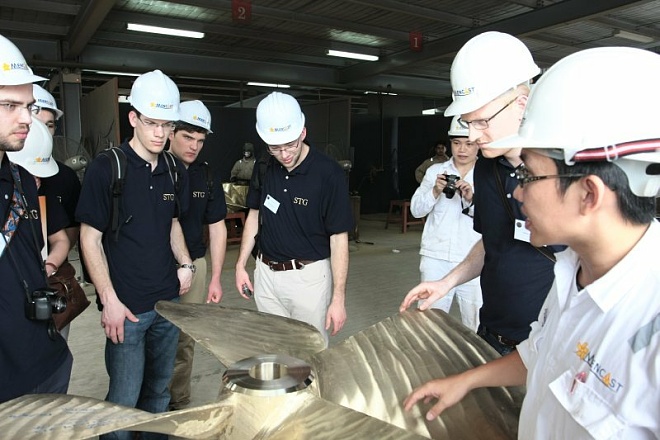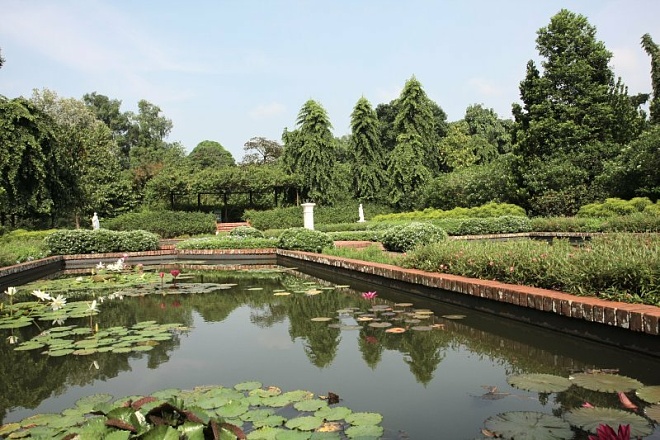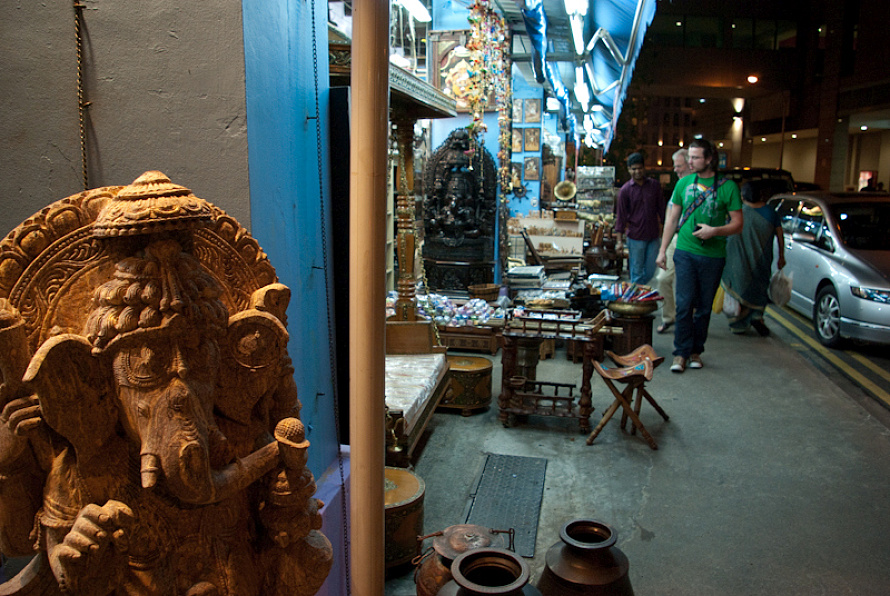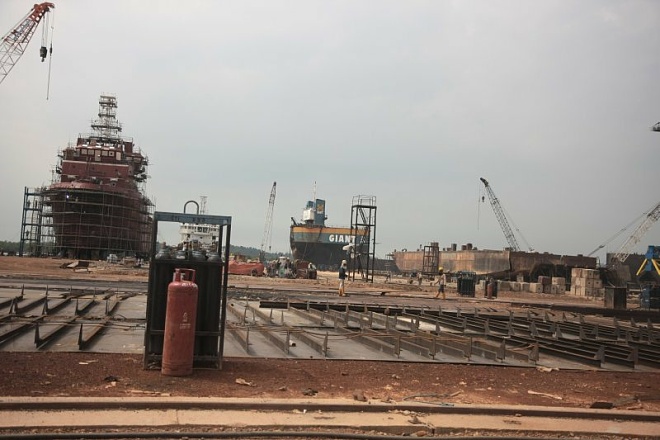The first day in Singapore

Before departure we met in Hamburg Airport. Unfortunately, one person of our group had really big problems with a train connection. We hope to meet him tomorrow.
Our flight was trouble-free. We enjoyed the English cuisine at the
plane. After about 14 hours in two planes we arrived successfully in
Singapore.
On the way to the hotel by bus we got a first impression of the city.
Our accommodation seems to be fine (it has a great swimming pool on the
roof!) and now we are going to make our first walk through the city.
More information will follow...
... we went to the riparian Esplanada Mall and had delicious dinner at a typical asian food-court.
Day two
New day and what the world needs:
Talents, Growth,
Sustainability - the keywords of today. At the Singapore Economic
Development Board (EDB) we were introduced to the keys for success and
the strategic goals of Singapore. People from all over the world are
welcomed to participate at the growth of this city - which is incredible
14.5 % of GDP in 2010.
But not just the growth is in
focus, although sustainability is seen as a key factor for the region.
So Singapore for example plans to have autonomous water supply till
2061!
As a perfect finish, we got an beautiful overview
from the 28th floor of the "Raffles City Tower" to the skyline of
singapore, where the EDB is situated.
After a good asian lunch, we were brought to Mencast, a supplier for
the shipbuilding industry. It is situated in an industry park in the
west of Singapore and produces propellers, shafts, rudders and other
stern-gear equipment.
After a warmly welcome by the CEO
Mr. Glenndle Sim, we had a tour through the workshop. We had the chance
to see the foundry in progress just as repair works at used (and
grounded) propellers.
After the first day we looking forward to have more exiting days in a very fascinated city with a great atmosphere.
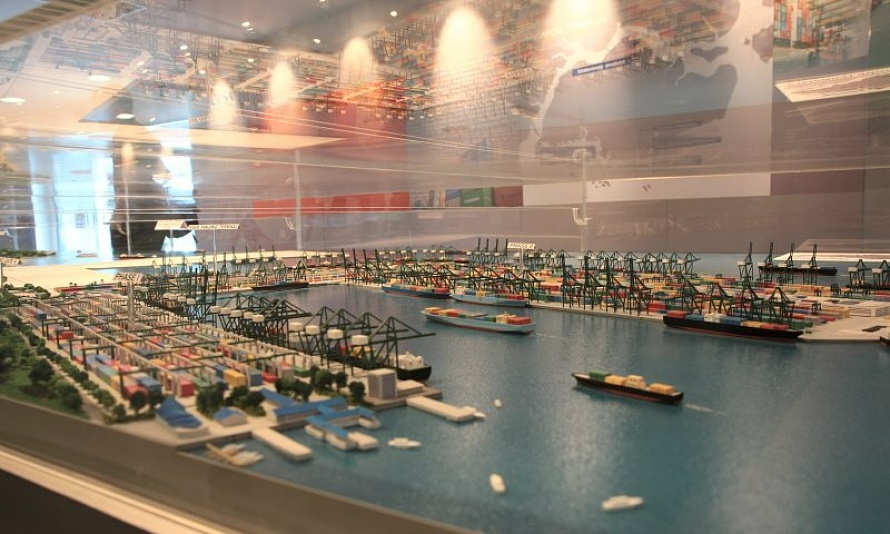
Can it be greater to start a new excursion day with a wonderful view over the port of Singapore from 40th floor of the PSA building? Assure oneself!
PSA- Port Singapore Authority- has in Singapore one of the busiest and
largest container terminals in the world. (And we will see, if Singapore
recaptures the title as largest container port in the world.)
The
success grounded on stable economic conditions, efficient container
handling and excellent connectivity to more of 600 other ports worldwide
(to be exact: 123 countries). Singapore was and is number one of the
container transshipment hub.
To see, how the container handling looks like in reality, we got the
chance to drive through the Pasir Panjang Terminal, one of the 5
Terminals, with a quay length of about 8 kilometres. PSA has about 16
kilometres of quay length today in Singapore and handles over 26 million
TEU. With new terminals under construction even during the economic
crisis, Singapore is looking forward to double his container capacity.
They will finished the necessary land reclamation for the new terminals
in 7 years.
After a short break in the Vivo Shopping Mall for lunch we went to the German embassy.
The
Deputy Head of Mission, Mr. Jens Janik, gave us an interesting overview
about the Singaporean politic and an inside-view about their work as
well. At this stop we got a different view about Singapore. We mentioned
the aspects of living, education and some other facts in foreign
country. At the moment live and work about 7100 Germans in Singapore.
And what was the reason to visit the embassy?
The answer
is, that we think, it is very important to have a look beyond one's own
nose. So it was great to get some clear, real information about the
history, life and politics of Singapore
Today we decided to discover an new area of Singapore and went to China
town with narrow, colourful and busy streets. Singapore is a melting pot
of different religions. It is possible here, that two big temples
located very close. This visit added a additional cultural and social
touch to our third day
Day four
Today’s new motto: „Growth – turn your vision into reality“.
First
appointment of the day was a presentation given by the vice president
of OTTO Marine Limited. This company, the 5th largest shipbuilder in the
world for AHTS vessels (Anchor Handling and Tug Supply Vessels),
provides chartering, shipbuilding and special services.
In
fact we were told that to reduce costs even the Singaporean company
outsources their building facilities to China but on the other hand it
takes some time to transfer the knowledge and quality management. That
is why OTTO Marine Limited sends supervising instructors to the yards in
China. It is very interesting to see that the basic design of their
vessels is done in Norway and Ukraine.
Next part of our excursion was a visit of the EMAS Offshore Services Pte
Ltd, which is actually a shipping company for offshore support vessels.
But on top of a normal company they provide special training programs
for anchor handling, dynamic positioning and engineers for their crew.
Mr. Kalyan Chatterjea, the Academy Consultant, and his instructors gave
us a very warm welcome and it was a pleasure to get some information
about the operation of a vessel which is very rare for us as naval
architects.
Highlight has been the visit of the simulator bridge of an offshore
support vessel, made by Kongsberg, which allows the operator to drive
fore and aft. Major aim of the academy is to test and improve the skills
of their own crew and later on maybe they open up for other crew.
After a delicious lunch at the canteen of the NUS, the National
University of Singapore, we were introduced to Prof. Choo Yoo Sang. He
showed us the projects according to maritime tec hnology in a very kind
manner and explained every single question with a smile on his face. Key
research projects in collaboration with commercial companies and yards
in Singapore are the oil and gas production. The engineering faculty is
running partnerships with classification classes as well. They push on
special projects like floating container terminals or floating oil
reservoirs in dimensions of a quarter of a 1 km².
To complete
the visit at the NUS we got a quick view of the mechanical laboratories.
At any time we got the feeling that Prof. Choo Yoo Sang wants to
encourage us to spend a semester at his university – we will see, may
be.
Day five
The 5th day was definitely a highlight of our excursion so far.
The
day started with sunshine, which was perfect to visit the botanic
garden of Singapore, which was established over 150 years ago. It is a
beautiful place to leave the noise and rush from the city behind and
have a nice walk through the different local vegetations. The garden is
divided into different themes like the so called “Evolution Garden”,
“Rain Forrest” or of course the “Orchid Garden”. Due to our tight
time-schedule, we unfortunately had to skip the famous “Orchid Garden”.
More informations about the botanic garden can be found on the website
www.sbg.org.sg.
After a lunch break in of the numerous
food courts we were picked up to visit Keppel. Keppel Group has
different interests, e.g. offshore & marine, infrastructure,
property and investments. In total it owns 20 shipyards all over the
world. In Singapore there are 7 different shipyard facilities located
where up to 30,000 people are employed. They are a major player in the
offshore business and have build over 50% of all jack-ups and
semisubmersibles during the past 10 years. Despite of the manufacturing,
Keppel also provides the full design of their products.
Our visit was divided in two parts.
After
a welcome from Mr. Charles Foo, the deputy director of KOMtech (Keppel
Offshore & Marine Technology Center), we were listening to
presentations of the Keppel Group, as well as the research fields of
KOMtech. During a tour through the offices of KOMtech, we had the chance
to get even more inside-information about the various projects KOMtech
is looking into. Mr. Asbjørn Mortensen was so kind to accompany us at
the whole time and give us additional insights into the research
projects. The research fields within KOMtech which were presented to us
are ranging from materials, CFD, design, process optimization and
several others.
In the second part of our visit we got the chance to see the shipyard
“Keppel FELS,” which is located is located in the south of Singapore. At
this facility Keppel manufactures mainly offshore structures like
jack-ups and semisubmersibles. Right at the beginning of our tour we got
a first impression of the dimensions of this single shipyard as we saw
the numerous busses, which were waiting to transport the workers back to
their accommodations.
Furthermore it was deeply impressive to
see the numbers and sizes of the semisubs which were moored at the
quay-side. It was really a unique experience as these kind of giant
structures in many places of the world. The whole shipyard is packed
with workers, shops, tools and materials as space is in general a rare
value in Singapore. Also we got a glimpse of the impressive “Asian
Hercules” crane barge which is lifting up to 1,600 t.
To
finish a perfect day we were invited to the “STG – Maritime Evening”
which was kindly hosted by GL in the Raffles Town Club. After a few
drinks in the lobby and informative speeches and greetings from Lukasz
Luwanski from GL Singapore, Iwer Assmussen from STG and Thiessen Lau
from Rickmers Shipowning & Shipmanagement the delicious buffet has
been officially opened.
During and after the dinner we got the chance to talk to other guests from the maritime industry as well as local students.
In
total the evening had a nice and private atmosphere in a beautiful
location. Once again we would like to take the opportunity to thank GL
for their support, not only on this event.
Day six
The day after the STG evening happened to have another packed schedule
waiting for us. Starting off at 8.30 our bus left for PaxOcean's offices
which rather resembled the style of the local hospital than the overly
polished conference rooms we have mostly seen over the last days.
Still,
PaxOcean being the designer and builder of offshore vessels for other
companies of the Kuok Group made a relatively sophisticated impression.
While in the company's early days PaxOcean only turned Norwegian designs
into reality, they are now offering the whole package from basic design
to workshop drawings. Their in-house team basically relies on the
industry-standard tools and software packages also seen on Western
yards, like NAPA and AVEVA Marine. In their presentation they also
mentioned to be a customer of European towing tanks (HSVA, …).
Opposed
to the design and engineering work which is solely done in the
Singapore Headquarters, actual production takes place in the paradise of
low-cost labor - China. The smaller of the two PaxOcean yards is
already in operation for a few years now, while the construction of the
second and way larger facility close to Shanghai is still underway as of
today. Scheduled to be finished by the end of this year, it will
provide a fully-equipped shipyard including drydocks of up to 400x100m
in size, also allowing for the latest generation semi-subs and offshore
rigs to be docked.
Next up and still before lunch time
was POSH, sister company to PaxOcean, a global player in ship management
for offshore vessels. POSH is managing more than 50 ships and about 20
barges distributed all over the world (excluding Europe!). Interestingly
they are also having small ship repair facilities on-site for
maintenance work and minor repair purposes.
Although the
next bullet on our list was Contact Singapore, we had to fit in a visit
at PSA's Pass Centre to obtain port passes for Sunday's visit aboard
"Mærsk Essen". Leaving a bunch of fingerprint and photos there made us
skip the lunch break, being headed for Contact Singapore right
afterwards.
Back in the EDB building in downtown
Singapore, Zhi from Contact Singapore who already joined many of our
previous visits gave another more detailed presentation on work and life
in Singapore. That also included legal issues like taxation, the visa
application process, employment passes and much more. New to us was the
concept of the WHP, which offers students and graduates an easy
possibility to stay and work in Singapore for a duration of 6 months.
Later,
refreshments were followed by corporate presentations of ABS, MAN
Diesel and HATLAPA which pointed out different aspects of doing business
in Asia in general and Singapore in particular. MAN, being represented
by the Human Resources Manager focused on work-life balance and work
atmosphere which apparenly includes a number of social events like
Chinese New Year celebrations, bowling competitions and so on.
Last
on stage was Mr Nürnberg, HATLAPA's CEO, who gave a good insight on
doing business in Asia as a German company and marine supplier. Being
around here for some 15 years already, he also expressed his concerns
about the German maritime industry being left behind the very active,
focused and responsive Asians.
After 9 hours straight at
various places around the city, many of us decided to conclude the day
with good food, cold beers and some live music at Marina Bay Waterfront
and Clarke Quay.
Day seven
After the last busy days the most of us used Saturday morning for
relaxing or sight-seeing.
Today we had only one appointment at the Singapore International
Foundation (SIF). The SIF is a non-profit organisation with the mission
to build a better world through sharing ideas and a better understanding
between the Singaporeans and world communities.
They
also organise Singapore Discovery Weekends for arrived expatriates and
professionals already working in Singapore. Fortunately we could
participate in such a weekend and visited the Urban Redevelopment
Authority (URA). The URA works on long time strategic plans and detailed
local area plans for physical development and then coordinates to bring
the plans into reality.
After a welcome we got an introduction about the history and expansion
of Singapore. On a large model we had a good overview about the coming
up districts and land reclamation. It was interesting to get to know
that buildings are not allowed to become higher than 280m because of
security and aviation reasons.
After some nice pictures of
Singapore live and a presentation we had a lunch break and in the
meantime we got some impressions in URA’s Singapore City Gallery of the
heavy changes in the last 60 years.
Saturated we were brought to the Pinnacle@Duxton, the first 50-storey
public housing project, built in 1963. These are seven towers with 1,848
apartments connected with two sky bridges at 26th store and the top of
the building.
A guide was talking with us due a small
trip with a bus around this building. He was telling about the history
of Singapore and its traditions. The excursion continued on the sky
bridge on top of the building. Being there you get a lot of impressions.
It is really possible to see all parts of the city. You can go walking
on a roof. There is enough room rather for jogging. People who leave
there do it.
From there we could see all the facilities in the port of Singapore very
well. It was possible to see container terminals very clearly.
On
the other hand you can understand the differences between modern and
old cultures. It’s possible to see an old part of a china town with its
small houses and a big temple. Our guide told us some stories that in
old “good” times it was possible to eat there snakes, which were killed
and cooked on your eyes. Also he told us about some fire cases in the
city and how they began to build tower buildings.
The
main idea of the speech was that people could improve they life very
rapidly: for example, 30 years ago a lot of them had to rent a flat and
now most have their own flat.
We made many photos and got
a very good mood for the last part of the day, what we used for
visiting a “little India” – an Indian block with traditional houses and
shops.
Day eight
On Sunday a visit on Maersk Essen, a 13.100 TEU Container vessel, was
scheduled. In the morning we were informed that the arrival of the ship
was rescheduled from 2 p.m. to 8 p.m. So a few of us relaxed at the
pool, others visited the fascinating "Marina Bay Sands"-Hotel. It was an
amazing view of the city, the new reclaimed land with its big
construction sites and of the ships waiting for passing the street of
Malacca.
At 8 pm a bus fetched us. After entering the Safety-Area of the PSA, our
bus brough us to the biggest ship in harbour: The "Maersk Essen". The
long gangway up to the maindeck let us imagine which dimensions were
waiting for us. We were divided into two groups for the tour through the
ship. Passing thousands of containers, we went down to the main engine
situated aft. In estimated 50°C, the crew showed us everything and
answered questions professionally. What surprised us most, was the
enormous free space everywhere: The bridge, the accomodation rooms, the
crew relaxing rooms. Thus the crew was very satisfied with their ship,
because they can work in very good circumstances. At midnight we left
the vessel and returned to our hostel.
It was a great time on the "Maersk Essen" and we have to say a special
thank to the crew and all other involved persons, which organized this
big event.
After a great night on Maersk Essen, we started day nine with the
trip to Jurong Shipyard. The Jurong Shipyard is one of 7 shipyards
around Singapore who belongs to the main-company Sembcorp Marine. In
addition to these shipyards, sembcorb marine has strategically located
other yards and offices in China, Brazil, USA, India and the Middle
East. Sembcorp Marine delivers during their existence a diversity of
different products and services. Since 1963 they do ship repair,
shipbuilding, ship conversion, rig building and offshore products. Their
focus is today on offshore platforms and floating production
facilities, like jack-ups, semi-submeribles, FPSO, FPU, TLP's, as well
as on 2600 TEU container vessels and LNG tanker.
Our
program started with a warmly welcome-round of introductions and a
presentation about the company. They invited also ten of their young
engineers from various fields. The presentation gave us a good all-round
view about the company. Jurong shipyards have 9000 employees at the
moment and will deliver 5 platforms this year. The price is 1 billion US
dollar and the construction period is about 28 months. After the
presentation we have made a shipyard-tour by bus and we had the chance
to leave the bus for a while to get a better impression of the very
giant semi-submeribles.
At the end we got a delicious lunch and had many stimulating discussions with the young engineers.
Day nine

The rest of the day we had time to go to Sentosa, a small island of Singapore. It is the regeneration-holiday-island for the locals - a real big cheesy and phoney world. One of the "highlights" was the possibility to make a picture with a big snake, a oriental hat and a man, who played for 30 seconds his flute for only 5 Sing-dollar. From Sentosa you have also a great view of plenty of old vessels and industry, so the conclusion is: Its must be the paradise :)
Day ten
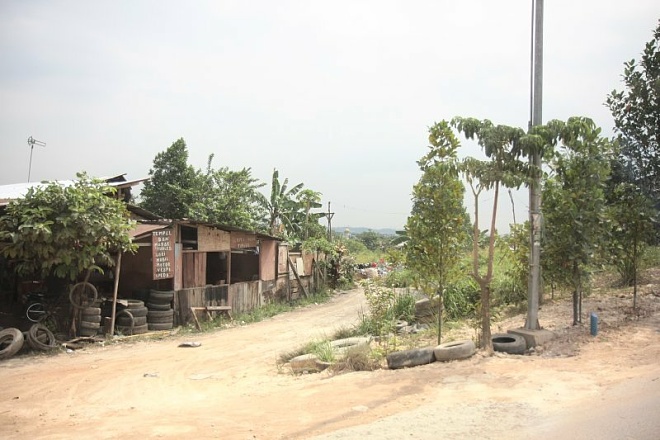
This day started very early at about half-past five and the bus driver
picked us up at quarter-past six. We were brought to the port, where a
ferry to Batam (Indonesia) waited. Our first appointment was at the
“Marco Polo Shipyard” and after a lunch we visited the “MCDERMOTT Yard”.
Not knowing, what we have to expect, we were a little bit shocked and
surprised. On the way from the port of Batam to “Marco Polo” we passed
some “towns” with poor humans living in houses made of planks and
corrugated iron. At the end of this trail, we founded the shipyard
“Marco Polo”. Marco Polo is a new yard finished in 2008 and builds, with
300 employee and 1000 workers from subcontractors, new ships or does
repairings. The business of new build ships generally consists out of
accommodation barges and sometimes supply vessels. Everything is done in
the two docks with a length up to 175m or in the field next to them.
Sometimes, the hole new build ships, don’t care if barge or vessel, is
completed on the field. After finishing, the ship is lifted with long
balloons and rolls on it into the water.
The efficiency of the yard is not as good as we saw on other yard. Marco
Polo has no panel street. The panels are welded by hand and open air on
the none flat sandy ground. This decreases the workload and quality but
also the costs. The cost advantage compared to Singapore is round about
20% to 30% for repairings and 10% to 15% for new build ships.
After having a lunch in a well prepared and nice restaurant, we had a
meeting at “MACDERMOTT”. The whole company with 14400 employee has six
engineering offices and seven yards worldwide. The yard of Batam had
been finished 1970 and has 5983 workers now. Their business consists out
of offshore decks, jackets, accommodation and heavy lift barges. The
whole yard is very efficient equipped with big machines. For example,
they can role their own tubes up to a plate thickness of 120mm. Actually
the biggest project is a jacket with a mass of 23000t for a water
depth up to 130m.
Additional to modern production, safety and social commitment is a big
point of Macdermott. For example, they build accommodations for
orphans, schools and helps to bring in the waist separation. One
highlight was the way bag to the ferry. We started at finishing time
together with round about 1000 scooters and 3000 people sitting on them.
The two trail street was added with two new trails and the safety
distance decreases down to half a meter.
This day provided an insight into another world just some kilometers
away from Singapore and let us know how two completely different yards
are able to exist in the same business and area.
Day eleven
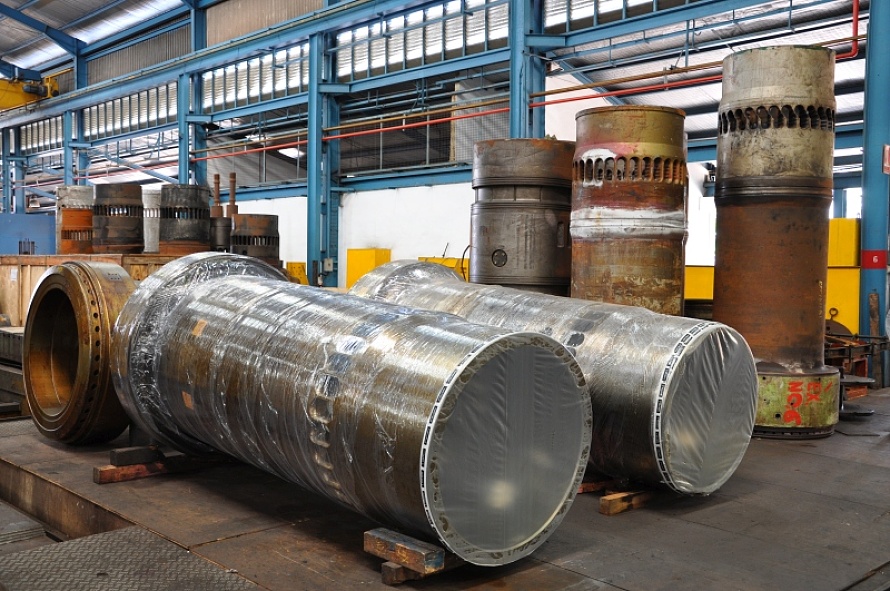
With three more companies to visit, we had another busy day in
Singapore! We started at the Singaporean office of Wärtsilä. At first we
got a brief introduction into the history of Wärtsilä which has been
founded in 1834 and is nowadays a leading supplier of ship power
solutions. The Singaporean office has currently approximately 750
employees. The core business of the Singaporean office is the Service,
whereas the other fields Ship Power and Power Plants make together less
than 7 % of their net sales. Also interesting to see was the percentage
of employees in comparison to the net sales. In Europe 56 % of all the
employees are stationed and 28 % of the net sales is being acquired,
whereas the Asian market has 31 % of employees but 39 % of the net sales
is being produced. This highlights once again the importance of the
Asian market regarding the sales, but also the still strong engineering
work which is being done in Europe.
Afterwards we got another small
presentation about the services which are being done in Singapore. Once
we were done with the presentation, we had the chance to see the
workshop. There, all the work on the liners, pistons, valves etc. are
carried out. After the visit of the Maersk Essen with its impressive
12RT-flex 96C, it was interesting to see the dimensions of the inner
parts of such an engine.
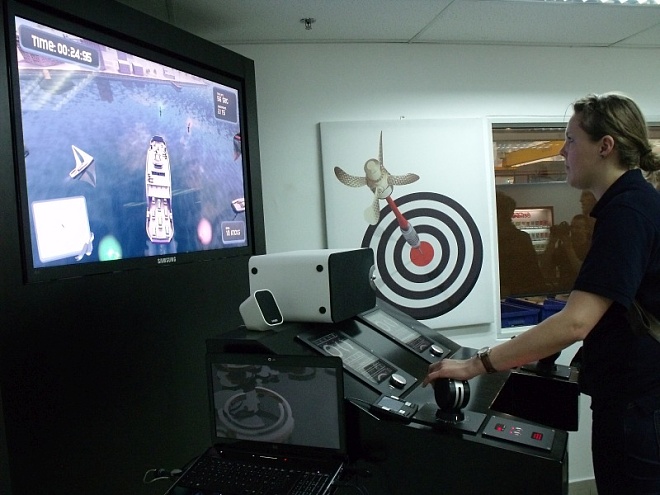
Next we needed to hurry to be in time at Berg Propulsion. At first we
got a presentation of the company’s history and their current products
which are controllable pitch propellers (CPP), fixed pitch propellers,
thrusters, azimuth thrusters, hydraulic systems, as well as the recently
introduced control systems. Berg Propulsion has the largest market
share of midsize CPP’s, which range from 1.5m – 8m, respectively from
300kW – 20,000kW. Once again we got the chance to have a look into the
workshop, where we found impressive state-of-art machineries to produce
their products. The facility in Singapore is not carrying out the
casting but more the finishing of the individual products. After a short
lunch break which was held nearby, we came back to Berg Propulsion to
see their small simulator, were their latest control systems are usually
shown to customers. This control system is being connected with a
little game, were a double-end ferry has to be maneuvered through a
harbor. All of us had a lot of and one of us even made the second place
in the all-time high score.
Last but not least we went to see the Singaporean office of Rolls Royce.
After two introductorily movies and a quick presentation of the overall
products and services Rolls Royce is doing we held a short Q & A
about the different locations, company structure, etc. of which Rolls
Royce consists. It was interesting to see the progressive development of
the company within the marine market. Afterwards we were shown the
workshop. Unfortunately for us, most of the products were being shipped
out of the workshop the day before. Nevertheless we got a good
impression of the facility and specially their extensive quality
management which is being carried out.
Once again we had a good insight into three suppliers, their products as well as their workshops.
Day twelve
This day began with a visit at NTU (Nanyang Technological University). Actually this University does not offer studies in ship design in a classical manner but is involved in several research projects related to marine engineering. We visited different so-called schools, which are situated within the college of engineering, being one of four colleges at the university.
Founded as recently as last year, but already employing more than 200 researchers and accessing funds of about 100m Euro the „ERIAN“ (Energy Research Institute) is focusing on the nascent clean energy of wind and marine renewables, energy storage, green and smart buildings and fuel cells. Under the head of this institute the „Centre for Maritime Research“ (CMER) is working together with DNV on ocean renewable energy research as well as in greener shipping issues. In terms of „Green Ships“ NTU and DNV try to find alternative fuels, do research in electric propulsion and work on carbon capture procedures. Next to nuclear power, fuel cells and biofuels gained from palm oil do in their opinion constitute a suitable solution for the upcoming environmental problems arising from the usage of heavy fuel oil.
The school for mechanical and aerospace engineering has more than 3000 undergrads and about 350 PhD students and is doing some research on hull optimization as well as on hull-propulsor interactions. In the school of civil and environmental engineering we saw the laboratory for simulating earthquakes with the target to analyze concrete structures and to find ways for making buildings stronger and safer.
After lunch in the modern and well organized canteen we headed to GL in Downtown Singapore. We gained a good insight into GL’s daily work, especially in the ship survey business in southeast Asia.
Day thirteen
Our last but one day in Singapore started with visiting the German Centre in Singapore. We were invited to Becker Marine Systems Asia.
Mr. Dirk Lehmann gave us a very interesting and thorough presentation about his company and a new division in Asia, in Singapore. We really enjoyed having the opportunity to hear the description of some technical details and were glad to understand them all. We were also told the secret of the company’s success and future perspectives of other shipbuilding companies.
In contrast to others, Mr. Lehmann told us also about problems, which his company faced at the very beginning of its activities in Singapore. By other companies we didn’t hear about any problems at all. Since Mr. Lehmann did not have enough time to answer all our questions, he invited us later on to a German beer restaurant in our last evening in the city. Of course we were pleased to take the proposal to spend the rest of the evening with him.
In conclusion, we discussed within our group in short all visited companies and what we learned from it. The discussion took few hours, so that each had a possibility to say a couple of words about each company. We summarized all opinions and impressions and this information will be presented as an article in the future.
The afternoon was used as last but one chance for Sightseeing and at 7pm we started our last evening with Mr. Lehmann, knuckles, schnitzel and white beer. He told us a lot of impressing and interesting things about his business until we have been the last group in the restaurant. For this invitation and great evening we would like to say a big thank you to Mr. Lehmann. After all we celebrated into Timo’s birthday and got some impressions of Singapore's nightlife.
Day fourteen

Our last Day in Singapore started easy going. We packed our bags and set
out for the city a last time. Some of us used the last chance for
visiting the observation deck of the "Marina Bay Sands"-hotel, others
bought a few gifts for their families and friends at home. At 20 o'clock
our bus driver Ricky, who gave us a safely transfer through Singpore
the last 14 days, picked us for the transfer to the airport. Kindly, 4
singaporean students from NUS we met at the STG-evening waited at the
airport for saying us goodbye.
After a quiet flight and stopover in London, we landed on Sunday morning
in Hamburg at 10.15 clock local time. Except for one student who wanted
to visit Malaysia three weeks, everyone is back safely. With a polo
shirt on which we had printed a group photo, we thanked our companion
Iwer Asmussen for travelling with us. He hadn't just travelled with us,
with him we experienced the 14 days fully of interesting company visits
and different impressions from an overwhelming city. Singapore was a
unique opportunity for us getting "the whole overview".
Once again, we want to say thank you, especially to Iwer and Dirk
Lehmann from Becker Marine Systems, and all who supported us and made
this excellent journey possible.


